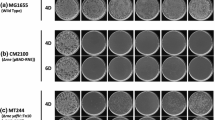Summary
We have cloned the pps gene, coding for PEP synthase, of Escherichia coli. PEP synthase catalyses the ATP-dependent conversion of pyruvate into phosphoenolpyruvate and is required for gluconeogenesis. The pps gene was cloned by an in vivo cloning method using a mini-Mu-lac bacteriophage containing a plasmid replicon. Upon expression of the cloned pps gene in the maxicell system a protein with an apparent molecular weight of 84 kDa was synthesized. The position of the pps gene of the plasmid was localized by restriction analysis of isolated transposon insertions and the determination of the PEP synthase activitics of the different clones. An operon fusion between the pps gene and the galK gene was constructed. Measurements of the galactokinase activity in Salmonella typhimurium galK and galK fruR mutants showed that the transcription of the pps gene requires the presence of FruR, the repressor of the PEP: fructose phosphotranferase system (PTS) in E. coli and S. typhimurium. To test whether the components of the Fructose PTS, in particular FPr, are involved in the expression of the pps gene, we investigated a S. typhimurium galK strain, containing the fusion plasmid, in which the chromosomal fru operon was inactivated by a transposon insertion. Measurements of the galactokinase activity showed that the absence of the Fructose PTS proteins has no significant influence on the regulation of the pps gene.
Similar content being viewed by others
References
Aiba H (1983) Autoregulation of the Escherichia coli crp gene: CRP is a transcriptional repressor for its own gene. Cell 32:141–149
Appleyard RK (1954) Segregation of new lysogenic types during growth of a doubly lysogenic strain derived from Escherichia coli K12. Genetics 39:440–452
Birnboim HC, Doly J (1979) A rapid alkaline extraction procedure for screening recombinant plasmid DNA, Nucleic Acids Res 7:1513–1523
Brice CB, Kornberg HL (1967) Location of a gene specifying phosphopyruvate synthase activity on the genome of Escherichia coli K12. Proc R Soc Lond [B] 168:281–292
Calvo JM, Goodman M, Salgo M, Capes N (1971) Salmonella locus affecting phosphoenolpyruvate synthase activity identified by deletion analysis. J Bacteriol 106:286–288
Chin AM, Feucht BU, Saier MH Jr (1987) Evidence for the regulation of gluconeogenesis by the fructose phosphotransferase system in Salmonella typhimurium. J Bacteriol 169:897–899
Cooper RA, Kornberg HL (1967) The direct synthesis of phosphoenolpyruvate from pyruvate by Escherichia coli. Proc R Soc Lond [B] 168:263–280
Englesberg E, Wilcox G (1974) Regulation: positive control. Annu Rev Genet 8:219–242
Geerse RH, Ruig CR, Schuitema ARJ, Postma PW (1986) Relationship between pseudo-HPr and the PEP: fructose phosphotransferase system in Salmonella typhimurium and Escherichia coli. Mol Gen Genet 203:435–444
Geerse RH, Izzo F, Postma PW (1989) The PEP: fructose phosphotransferase system in Salmonella typhimurium: FPr combines Enzyme IIIFru and pseudo-HPr activities. Mol Gen Genet 216:517–525
Groisman EA, Castilho BA, Casadaban MJ (1984) In vivo DNA cloning and adjacent gene fusing with a mini-Mu-lac bacteriophage containing a plasmid replicon. Proc Natl Acad Sci USA 81:1480–1483
Hirschman J, Wong PK, Sei K, Keener J, Kustu S (1985) Products of nitrogen regulatory genes ntrA and ntrC of enteric bacteria activate glnA transcription in vitro: evidence that the ntrA product is a sigma factor. Proc Natl Acad Sci USA 82:7525–7529
Hochschild A, Irwin N, Ptashne M (1983) Repressor structure and the mechanism of positive control. Cell 32:319–325
Jones-Mortimer MC, Kornberg HL (1974) Genetic analysis of fructose utilization by Escherichia coli. Proc R Soc Lond [B] 187:121–131
Kornberg H (1986) The roles of HPr and FPr in the utilization of fructose by Escherichia coli. FEBS Lett 194:12–15
Kornberg HL, Elvin CM (1987) location and function of fruC, a gene involved in the regulation of fructose utilization by Escherichia coli. J Gen Microbiol 133:341–346
Lowry OH, Rosebrough NJ, Farr AL, Randall RJ (1951) Protein measurement with the Folin phenol reagent. J Biol Chem 193:265–275
Mandel M, Higa A (1979) Calcium dependent bacteriophage DNA infection. J Mol Biol 53:159–162
Miyada CG, Stolzfus L, Wilcox G (1984) Regulation of the araC gene of Escherichia coli: catabolite repression, autoregulation, and effect on araBAD expression. Proc Natl Acad Sci USA 81:4120–4124
Narindrasorasak S, Bridger WA (1977) Phosphoenolpyruvate synthetase of Escherichia coli. Molecular weight, subunit composition, and identification of phosphohistidine in phosphoenzyme intermediate. J Biol Chem 252:3121–3127
Postma PW (1977) Galactose transport in Salmonella typhimurium. J Bacteriol 129:630–639
Postma PW (1987) Phosphotransferase system for glucose and other sugars. In: Neidhardt FC, Ingraham JL, Low KB, Magasanik B, Schaechter M, Umbarger HE (eds) Escherichia coli and Salmonella typhimurium. Cellular and molecular biology. American Society for Microbiology, Washington D.C., pp 127–141
Postma PW, Lengeler JW (1985) Phosphoenolpyruvate: carbohydrate phosphotransferase system of bacteria. Microbiol Rev 49:232–269
Reiner AM (1977) Xylitol and D-arabitol toxicities due to derepressed fructose, galactitol and sorbitol phosphotransferases of Escherichia coli. J Bacteriol 132:166–173
Sancar A, Wharton RP, Selzer S, Kacinski BM, Clark MD, Rupp WD (1981) Identification of the uvrA gene product. J Mol Biol 148:45–62
Scholte BJ, Postma PW (1980) Mutation in the crp gene of Salmonella typhimurium which interferes with inducer exclusion. J Bacteriol 141:751–757
Spassky A, Busby S, Buc H (1984) On the action of the cAMP-cAMP receptor protein complex at the E. coli lactose and galactose promoter regions. EMBO J 3:43–50
Stragier P, Patte JC (1983) Regulation of diaminopimelate decarboxylase synthesis in Escherichia coli. III. Nucleotide sequence and regulation of the lysR gene. J Mol Biol 168:333–350
Twigg AJ, Sheratt D (1980) Trans-complementable copy-number mutants of plasmid ColE1. Nature 283:216–218
Yamada M, Feucht BU, Saier MH Jr (1987) Regulation of gluconeogenesis by the glucitol Enzyme III of the phosphotransferase system in Escherichia coli. J Bacteriol 169:5416–5422
Author information
Authors and Affiliations
Additional information
Communicated by J. Lengeler
Rights and permissions
About this article
Cite this article
Geerse, R.H., van der Pluijm, J. & Postma, P.W. The repressor of the PEP: Fructose phosphotransferase system is required for the transcription of the pps gene of Escherichia coli . Molec Gen Genet 218, 348–352 (1989). https://doi.org/10.1007/BF00331288
Received:
Issue Date:
DOI: https://doi.org/10.1007/BF00331288



